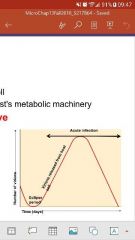![]()
![]()
![]()
Use LEFT and RIGHT arrow keys to navigate between flashcards;
Use UP and DOWN arrow keys to flip the card;
H to show hint;
A reads text to speech;
57 Cards in this Set
- Front
- Back
|
Characteristics of Viruses |
-obligatory intracellular parasites -contains DNA OR RNA -no Ribosomes -no ATP-generated mech -contain protien coat -some are enclosed by an envelope -some contain spikes -most infect specific types of cells in one host -no cytoplasm -not living |
|
|
Viruses can pass through ____. |
Bacteriological filters |
|
|
Host range |
The spectrum of host cells a virus can infect |
|
|
Most viruses infect only ____ |
Specific types of cells in one host |
|
|
Bacteriophages |
Viruses that infect bacteria |
|
|
Bacteriophages ranges |
20 nm to 1000 nm in length (1 macrometer) |
|
|
Virion |
Complete, fullty developed viral particle |
|
|
Capsid |
Protien coat made of capsomeres |
|
|
Capsomeres |
Subunits |
|
|
Envelope |
Lipid, protien and carbohydrate coating on some viruses |
|
|
Spikes |
Projections from outer surface of viruses |
|
|
Helical viruses |
Hollow, cylindrical capsid |
|
|
Polyhedral viruses |
Many sided |
|
|
Complex viruses |
Complicated structures |
|
|
Genus names end with ___ |
-virus |
|
|
Family names end with ___ |
-viridae |
|
|
Order names end in ___ |
-ales |
|
|
Viral species |
A group of viruses sharing the same genetic information & ecological niche (host) |
|
|
Viruses must be grown in ___ |
Living cells |
|
|
Bacteriophages form ____ |
Plaques |
|
|
Plaques |
Which are clearings on a lawn of bacteria on the surface of agar |
|
|
Each plaque corresponds to a single virus h is is expressed as ____ |
Plaque-forming units (PFU) |
|
|
Growing animal viruses in the lab in what two ways? |
1. Embryonated eggs 2. In cell cultures |
|
|
Virus growth in embryonated eggs |
-virus is injected in the eggs -virus growth is signaled by changes / death of the embryo |
|
|
Virus growth in cell cultures |
-Tissues are treated w/ enzymes to separate cells -viral infected cells detected via their deterioration known as CPE (cytopathic effect) -cont. Cell lines are used |
|
|
Cytopathic effect (CPE) |
Deterioration from virally infected cells detection |
|
|
Viral Identification (3) |
1. Cytopathic effects 2. Serological tests 3. Nucleic acids |
|
|
Serological tests |
-Detect antibodies against viruses in a pt -western blotting-reaction of a virus w/ antibodies |
|
|
Western blotting? |
reaction of a virus w/ antibodies |
|
|
Viral multiplication |
-growth curve -requires the virus to invade host & take over host's metabolic machinery |
|

What does this picture display? |
One step growth curve |
|
|
Multiplication of Bacteriophages |
1. Lytic cycle 2. Lyslgenic Cycle |
|
|
Lytic Cycle is defined as ___ |
Phage causes lysis / death of the host cell |
|
|
Lysogenic cycle |
1. Phage DNA is incorporated in the host DNA 2. Phage conversion 3. Specialized transduction |
|
|
Lytic cycle of T-even Bacteriophages |
-Attachement -Penetration -biosynthesis -maturation -release |
|
|
Attachment |
Phage attaches by tail fibers to host cell |
|
|
Penetration |
Phage lysozyme opens cell wall; tail sheath contracts to force tail to force tail core h DNA into cell |
|
|
Biosynthesis |
Production of phage DNA h protiens |
|
|
Maturation |
Assembly of phage particles |
|
|
Release |
Phage lysozyme breaks cell wall |
|
|
Lysogency |
Phage remains latent, dormant |
|
|
Prophage |
DNA dormant in gene |
|
|
Results in phage comversion |
The host cell exhibits new properties |
|
|
Specialized bacterial genes |
Transferred to another bacterium via a phage |
|
|
Animal viruses multiplication steps |
-Attachment -entry -uncoating -maturation -release |
|
|
Entry |
By a receptor-mediated endocytosis / fusion |
|
|
Uncoating |
Removing of capsole by viral / host enzymes |
|
|
DNA viruses replicate their DNA in ______ |
The nucleus of the host using viral enzymes |
|
|
Synthesize capsid in the ____ |
Cytoplasm using host cell enzymes |
|
|
Virus multiplies in the host cell's cytoplasm using _____ |
RNA-dependent RNA Polymerase |
|
|
3 Types of RNA-dependent RNA polymerarase |
1. ssRNA + (sense) strand 2. ssRNA - (antisense) strand 3. dsRNA double stranded RNA |
|
|
ssRNA (+) (Sense) Strand |
Viral RNA serves as mRNA for protien synthesis, single stranded RNA, can be read by ribosomes |
|
|
ssRNA (-) (antisense) stand |
Viral RNA is transcribed to a + strand to serve as mRNA for protien synthesis, double stranded RNA, cannot be read ny ribosomes |
|
|
Single stranded RNA produce ____ |
DNA |
|
|
Reverse transcriptase is used to ___< |
Produce DNA from the viral genome |
|
|
Retroviridae (2) |
1. Lentivirus (HIV) 2. Oncoviruses |
|
|
Viruses can cause several types of ____ |
Cancer |

